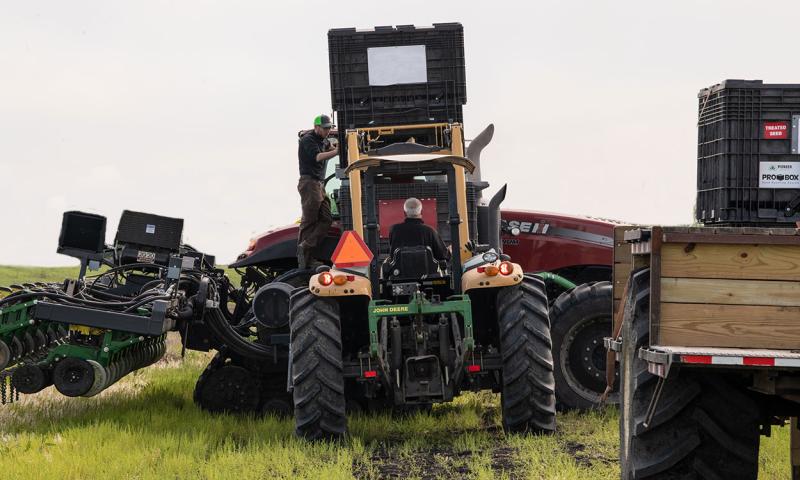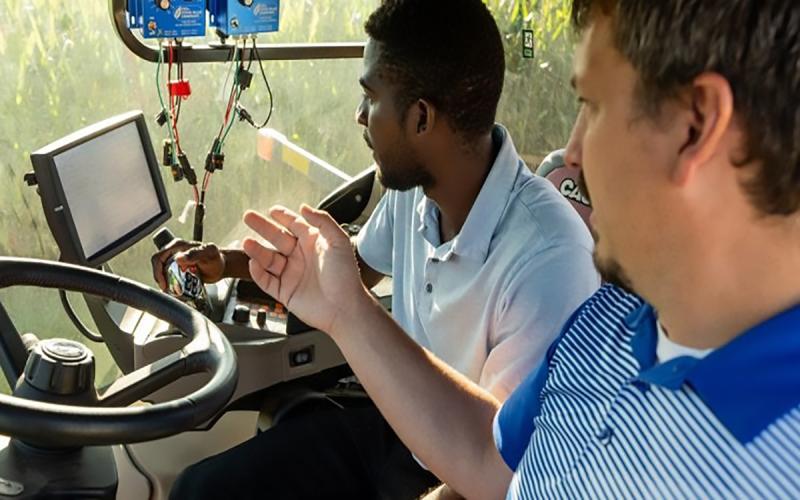
Planning for your farm and preparing your equipment is the way to success. Preparation will help save time, reduce unexpected costs, and increase your profitability and safety. Planting time is nearly upon us in much of the Midwest. Setting your planter up for proper planting of corn and soybeans can improve germination uniformity. As you start your planting preparation, consider the following tips that may help your planting operations.
Planter Preparation Tips
-
Level the Planter.
The planter toolbar needs to be leveled. The first step is to ensure your planter is leveled (the planter and the row units must be parallel to the ground. Use a level only if the ground is level; in field conditions, with slope, do not use a level). Suppose the hitch (the planter front) is lower than the proper level position. In that case, the row units will be in a downward, or downhill nose position, causing the disc openers rather than cutting the soil and the residue, pushing, or plowing the soil, and increasing fuel consumption. Suppose the hitch is higher than the level position. In that case, the row units will be in an upright nose position, resulting in seeds being dropped higher in the seed trench, and the seed firmers at the back of row units may put more downforce and make the soil around the seeds harder than expected. -
Check the Gauge/Depth and Down Pressure.
The depth adjustment linkages need to be checked for wear and function, including the depth adjustment handle, depth stop, and gauge wheel arms. Adjust down pressure (check your operator’s manual to ensure the downforce is enough; higher down pressure can increase the planting depth in drier conditions. In wet soil, less down pressure will reduce the compacted layer around the seeds. If there is not enough down pressure, the weight on the gauge wheels cannot control the seed depth. To check down pressure, pull the planter into the field with a quarter-full seed hopper to ensure the down pressure is enough when the planter is empty. Down pressure on a pneumatic and hydraulic system can be adjusted from the cab, while on a spring system, it can be adjusted according to the owner's manual. -
Meter Drive System.
As the heart of the planter, the seed metering mechanism needs to run at a high level of accuracy, and the worn components need to be replaced to maintain the highest accuracy. Check the drive system on the planter. On the ground drive system, make sure the tires, the contact drive, and the bearings are in good working condition; on hydraulic or electrical drive planters, ensure the hydraulic and electrical motors are functioning well. Check the transmissions and all drive chains, make sure the tensioners are working properly and chains have no kinks, move freely, and are appropriately lubricated. -
Parallel Arm Bushings.
The parallel arm linkages of the row units are to maintain uniform and smooth movement of the units attached to the toolbar. Worn bushings or damaged linkages can cause nonuniformity in seed spacing. The parallel arms need to be checked for vertical and horizontal row unit movement. Check the row unit’s parallel linkages and bushing wear within the bushings, pushing up the back of the row unit to see if there is excessive movement or if there is no wear on the bushings. Ensure all connecting bolts are torqued properly. If they are not correctly torqued, the row unit may “chatter” during planting, causing seed spacing to be compromised due to drop tube movement. -
Disk Openers.
The seed tubes and disk openers create the trench where seeds are placed. Check for blade wear and bearing wear. Remove the gauge wheel and blade to ensure their bearings are tight; before assembling the blade back on the hub, use a tape measure across the back face. If the blade diameter is under 14.5 inches, that blade and the center scraper between the blades needs to be replaced. The seed firmers need to be checked for wear and cracks to maintain the seed placement to the bottom of the trench and improve germination uniformity. Seed tubes guide the seeds to be placed about two inches deep, straight at the bottom of the trench, opened by the double disc openers, and packed with the closing wheels to give good seed-to-soil contact. -
Seed Tube and Seed Firmer.
The seed tubes and the seed firmers need to be checked for wear and cracks to maintain the seed placement to the bottom of the trench and improve the germination uniformity. Seed tubes guide the seeds to be placed at the desired depth at the bottom of the trench. -
Closing Wheels Spacing.
After seed placement in the trench, it is important to maintain good seed-to-soil contact using closing wheels with optimum adjustment. The gap between wheels wider than 2.5 inches from the bottom center to the bottom center may leave an open trench. A gap of less than 2 inches between wheels may force the sidewalls of the trench down, which can cause a delay in germination. If you have high amounts of trash, you may consider arranging the closing wheels in a staggered position, rather than directly across from one another, to improve trash flow through the closing wheel system. -
Checking General Items.
Make sure that the planter is mechanically sound. Check the grease fittings, make sure they all take grease, and nothing is bent, cracked, or broken. Inspecting the planter wiring and making sure they are routed and tied down properly with no catch or pinch points. Check all the bolts and connections and ensure everything is working. Check the fertilizer hoppers/tanks to ensure there are no cracks or holes and that all lids have proper latches. Ensure all the tires on the planter are inflated to the correct pounds per square inch, and recheck them right before you go to the field.


